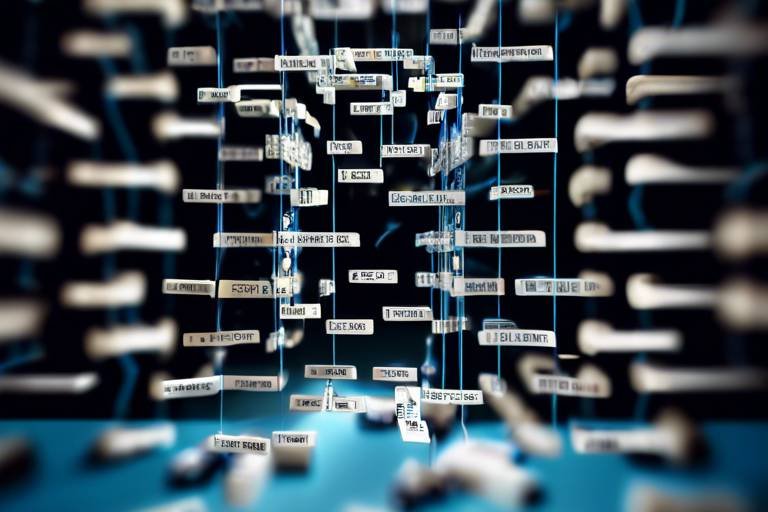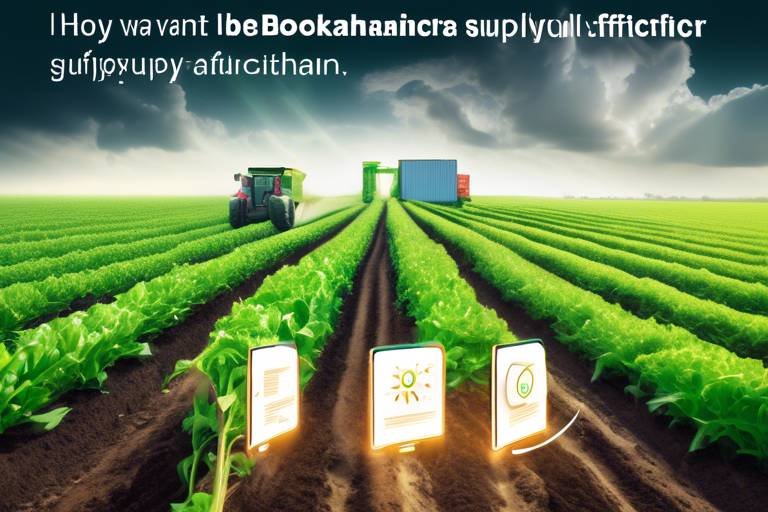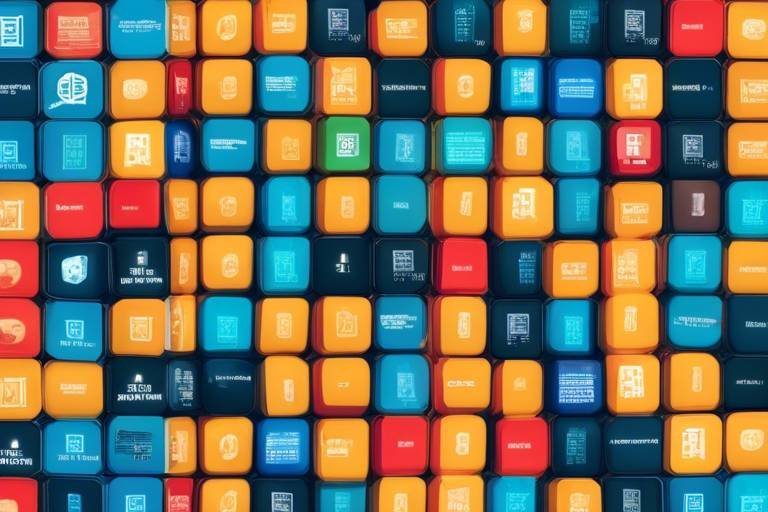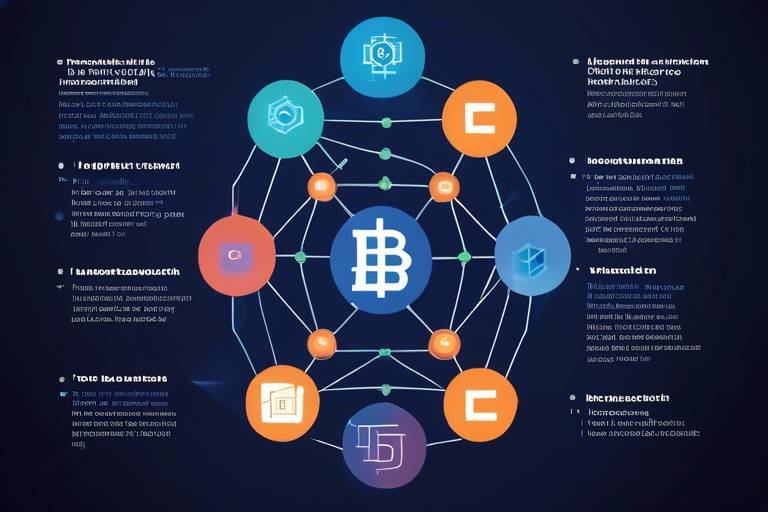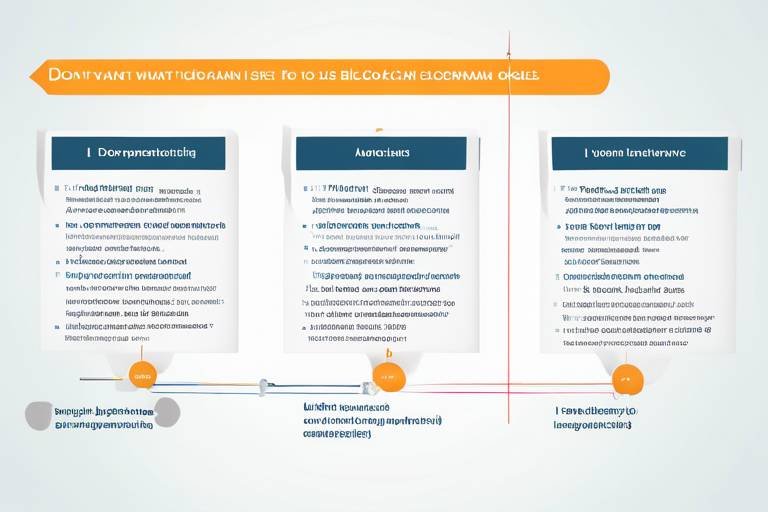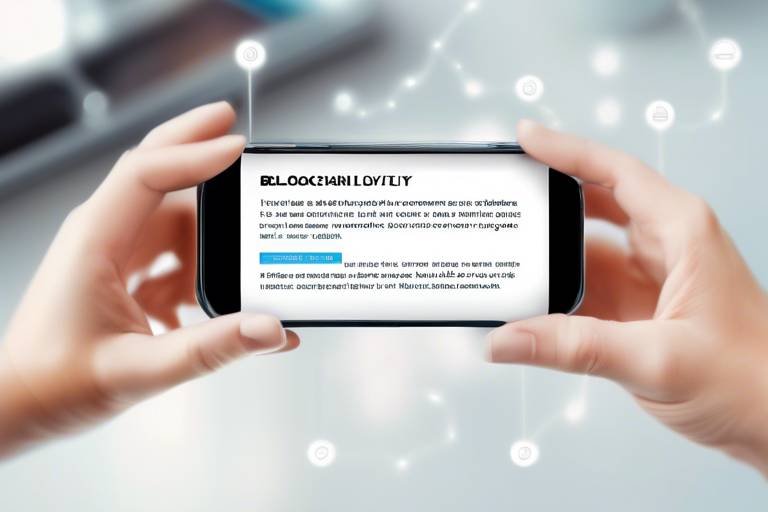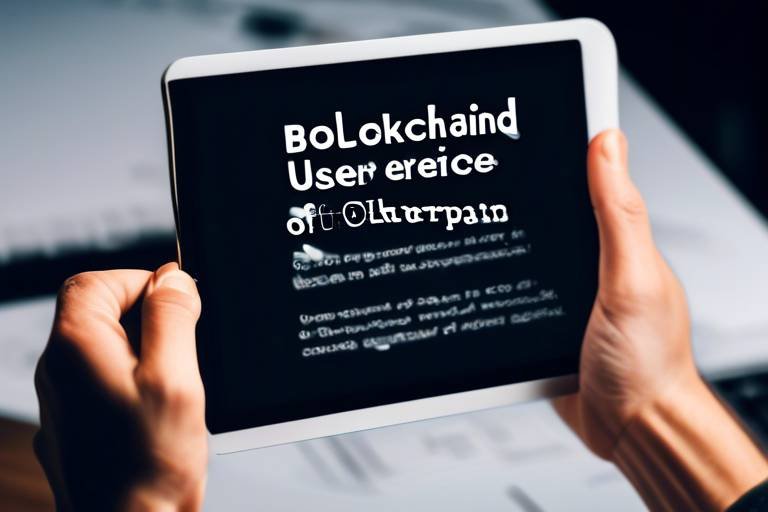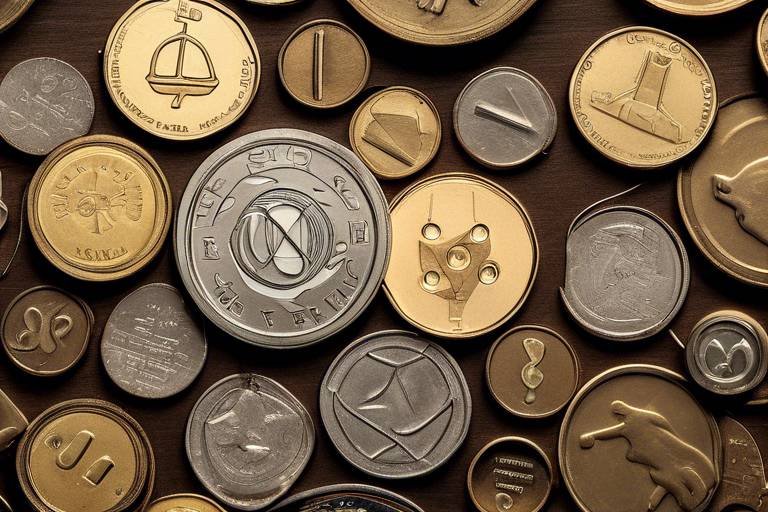How Blockchain Can Facilitate Efficient Public Procurement
In an era where efficiency and transparency are paramount, blockchain technology emerges as a game-changer for public procurement. This innovative technology has the potential to revolutionize how government transactions are conducted, ensuring that every step is transparent, secure, and accountable. Imagine a world where every procurement process is not only visible but also immutable, where fraud is significantly reduced, and trust between government entities and suppliers is restored. This article delves into the transformative potential of blockchain in public procurement, highlighting its numerous benefits, the challenges it faces, and its implications for the future of government transactions.
At its core, blockchain is a decentralized digital ledger that records transactions across multiple computers. Unlike traditional ledgers, which can be manipulated or altered, blockchain offers a unique set of features that make it particularly appealing for public procurement. These features include:
- Transparency: All transactions are visible to authorized participants, ensuring that everyone involved has access to the same information.
- Security: The decentralized nature of blockchain makes it resistant to hacking and fraud.
- Immutability: Once a transaction is recorded, it cannot be changed or deleted, providing a permanent and verifiable record.
These attributes make blockchain a promising tool for enhancing public procurement processes, paving the way for a more efficient and trustworthy system.
The integration of blockchain in public procurement can lead to a myriad of benefits that ultimately enhance the relationship between government entities and suppliers. By leveraging this technology, governments can achieve:
One of the most significant advantages of blockchain is its ability to provide a transparent record of all transactions. This transparency is crucial in public procurement, where stakeholders need to track procurement activities accurately. With blockchain, every transaction is recorded in real-time, making it easier to identify any discrepancies or delays. Additionally, this level of transparency can deter corrupt practices, ensuring accountability in government spending.
With blockchain technology, stakeholders can access real-time data on procurement processes. Imagine being able to track your order from the moment it is placed until it is delivered, with every step documented. This capability allows for immediate oversight and helps identify issues before they escalate, ensuring that procurement processes run smoothly.
Another critical feature of blockchain is its immutability. Once data is entered into the blockchain, it cannot be altered or deleted. This characteristic ensures that all procurement transactions are permanent and verifiable, creating a safeguard against fraud. In a world where trust is often compromised, this feature offers a reliable solution for maintaining integrity in public procurement.
Implementing blockchain can significantly lower administrative costs in public procurement. By automating processes and reducing the need for intermediaries, blockchain can streamline operations and lead to substantial savings for government budgets. Imagine the financial resources that could be redirected toward public services instead of administrative overhead!
Despite its potential, the adoption of blockchain in public procurement is not without challenges. Government agencies face several hurdles, including:
Many government agencies may lack the necessary infrastructure to implement blockchain effectively. Upgrading existing systems and ensuring compatibility with new technology can be a significant hurdle. Without the right tools and resources, the transition to blockchain may be slow and cumbersome.
The regulatory landscape surrounding blockchain is still evolving. Policymakers must address legal and compliance issues to create a conducive environment for blockchain adoption in public procurement. This process may involve rethinking existing regulations and crafting new ones that align with the unique characteristics of blockchain technology.
Several governments and organizations have begun experimenting with blockchain in procurement, providing valuable insights into best practices and lessons learned from early implementations. For instance:
Estonia has successfully integrated blockchain technology into its e-procurement system, enhancing transparency and efficiency. This case serves as a model for other nations looking to adopt similar solutions, demonstrating the practical benefits of blockchain in real-world applications.
The United Nations has explored blockchain applications in procurement to improve transparency and reduce corruption in humanitarian aid. These initiatives highlight the potential of blockchain in international procurement contexts, showcasing its versatility and adaptability across different sectors.
As blockchain technology continues to evolve, its application in public procurement is expected to expand dramatically. Future developments may include:
Combining blockchain with artificial intelligence can enhance decision-making processes in procurement. AI can analyze blockchain data to provide insights and optimize procurement strategies, making processes even more efficient and effective.
Smart contracts on blockchain can automate procurement agreements, reducing the need for manual oversight. This automation can streamline processes and ensure compliance with contract terms in real-time, allowing stakeholders to focus on more strategic tasks.
Q: What is blockchain technology?
A: Blockchain is a decentralized digital ledger that securely records transactions across multiple computers, ensuring transparency and immutability.
Q: How does blockchain enhance transparency in public procurement?
A: Blockchain provides a transparent and immutable record of all transactions, allowing stakeholders to track procurement activities in real-time.
Q: What are the challenges of implementing blockchain in public procurement?
A: Challenges include technological barriers, regulatory concerns, and the need for stakeholder education and training.

Understanding Blockchain Technology
Blockchain technology is often hailed as a revolutionary force in the digital age. But what exactly is it? In simple terms, blockchain is a decentralized digital ledger that records transactions across a network of computers. Imagine it as a highly secure, digital notebook that is accessible to everyone in the network, yet no one can alter or erase what’s been written. This unique feature of blockchain is what makes it so appealing for public procurement, where accountability and transparency are paramount.
At its core, blockchain operates through a series of interconnected blocks, each containing a list of transactions. When a new transaction occurs, it is verified by network participants (often referred to as nodes) and added to a block. Once the block is filled, it is sealed and linked to the previous block, forming a chronological chain. This process creates an immutable record of all transactions, meaning that once something is recorded, it cannot be changed or deleted. This characteristic is crucial in environments like public procurement, where the integrity of data is essential.
Here are some of the key features that make blockchain a game-changer in public procurement:
- Transparency: All transactions are visible to authorized participants, ensuring everyone is on the same page.
- Security: Data is encrypted and distributed across the network, making it nearly impossible for hackers to alter records.
- Decentralization: There is no central authority controlling the data, which reduces the risk of corruption and fraud.
Moreover, blockchain technology operates on consensus mechanisms, which are protocols that consider a transaction valid only when a majority of participants agree. This ensures that no single entity can manipulate the data, fostering an environment of trust among stakeholders. In public procurement, where distrust can lead to inefficiencies and corruption, this characteristic is particularly valuable.
In summary, understanding blockchain technology is essential for appreciating its potential impact on public procurement. By leveraging its inherent features of transparency, security, and decentralization, governments can create a more efficient and trustworthy procurement process. As we delve deeper into its benefits and challenges, it's clear that blockchain is not just a trend; it’s a transformative tool that could redefine how public transactions are conducted.

Benefits of Blockchain in Public Procurement
The integration of blockchain technology into public procurement processes is not just a trend; it's a game-changer. Imagine a world where government transactions are not only efficient but also transparent and trustworthy. That's the promise blockchain holds. By leveraging its unique features, public procurement can experience a significant transformation that benefits not only government entities but also suppliers and taxpayers alike.
One of the most compelling advantages of blockchain is its ability to enhance transparency. In traditional procurement systems, stakeholders often find themselves navigating a murky sea of paperwork and processes that can obscure the truth. However, with blockchain, every transaction is recorded in a transparent digital ledger that can be accessed by authorized parties. This means that anyone involved can track procurement activities in real-time, fostering an environment of accountability. If a supplier wants to verify that their bid was received and reviewed, they can do so without having to rely on potentially biased intermediaries.
Moreover, the real-time tracking capabilities of blockchain are revolutionary. Imagine being able to see the exact status of a procurement process as it unfolds. No more waiting for updates or relying on third-party reports that may be outdated or inaccurate. Stakeholders can instantly access real-time data, allowing them to identify discrepancies or delays promptly. This immediacy can help prevent issues before they escalate, making the entire procurement process more efficient.
Another critical benefit is the immutability of records stored on a blockchain. Once data is entered, it cannot be altered or deleted. This characteristic is essential for maintaining the integrity of procurement transactions. For example, if a contractor submits an invoice, that record is permanently etched into the blockchain. This feature safeguards against fraud and ensures that all parties can verify transactions without fear of tampering. In a world where corruption can undermine public trust, this level of security is invaluable.
Cost reduction is yet another significant advantage of utilizing blockchain in public procurement. By automating processes and minimizing the need for intermediaries, blockchain can significantly lower administrative costs. This efficiency not only saves time but also translates into substantial savings for government budgets. For instance, consider a scenario where manual paperwork and approvals can take weeks or even months. With blockchain, many of these processes can be automated, allowing government agencies to allocate resources more effectively.
In summary, the benefits of blockchain in public procurement are multifaceted. From enhanced transparency and real-time tracking to immutable records and cost reduction, the potential for improvement is enormous. As governments around the world look for ways to increase efficiency and accountability, embracing blockchain technology may very well be the key to unlocking a brighter future for public procurement.
- What is blockchain technology? Blockchain is a decentralized digital ledger that records transactions across multiple computers, ensuring transparency and security.
- How does blockchain improve transparency in public procurement? Blockchain provides a transparent record of all transactions, allowing stakeholders to track procurement activities easily.
- What are the cost benefits of using blockchain in public procurement? By automating processes and reducing the need for intermediaries, blockchain can significantly lower administrative costs.
- Are there any challenges to implementing blockchain in public procurement? Yes, challenges include technological barriers, regulatory concerns, and the need for stakeholder education.
- Can blockchain prevent fraud in public procurement? Yes, the immutability of blockchain records makes it difficult for fraudulent activities to occur.

Enhanced Transparency
One of the most compelling advantages of integrating blockchain technology into public procurement is the remarkable level of transparency it offers. Imagine a world where every transaction is recorded in a digital ledger that is accessible to all stakeholders involved. This is not just a dream; it is the reality that blockchain brings to the table. With its transparent record-keeping, every procurement activity becomes visible, allowing stakeholders—be it government agencies, suppliers, or the public—to track the flow of funds and resources seamlessly.
The transparency facilitated by blockchain can act as a powerful deterrent against corruption and fraud. When everyone can see the same information in real-time, it becomes significantly more challenging for dishonest practices to take root. For instance, if a government contract is awarded, all parties can view the criteria and the decision-making process that led to that award. This level of openness fosters a culture of accountability, encouraging responsible behavior among all participants in the procurement process.
Furthermore, blockchain's immutable records ensure that once a transaction is entered, it cannot be altered or deleted. This feature not only protects against fraudulent activities but also creates a permanent audit trail. Imagine trying to erase your footsteps in the sand; with blockchain, those footprints are etched in stone. This immutability is crucial for maintaining trust in public procurement, as stakeholders can always refer back to the original data if questions arise about any transaction.
To illustrate the impact of enhanced transparency through blockchain, consider the following key points:
- Real-Time Oversight: Stakeholders can monitor procurement processes as they happen, allowing for immediate identification of discrepancies or delays.
- Public Access: Citizens can access information about government spending, leading to increased public scrutiny and engagement.
- Accountability: With all transactions recorded and visible, government officials are more likely to act responsibly, knowing their actions are subject to public review.
In conclusion, the enhanced transparency offered by blockchain technology is not just about making information available; it's about transforming the entire landscape of public procurement. By ensuring that all transactions are visible, verifiable, and immutable, blockchain creates an environment where trust can flourish. The implications of this are profound, as it not only helps to curb corruption but also fosters a sense of collaboration and integrity among all parties involved in government transactions.

Real-Time Tracking
Imagine a world where every step of the public procurement process is visible in real time, almost like watching a live sports event unfold. With blockchain technology, this vision becomes a reality. Real-time tracking of procurement activities not only enhances transparency but also empowers stakeholders to make informed decisions swiftly. By leveraging blockchain, stakeholders—from government officials to suppliers—can access a centralized, tamper-proof record of all transactions as they happen.
This immediate access to data serves several crucial functions:
- Instant Oversight: Stakeholders can monitor procurement activities as they occur, allowing for immediate intervention in case of discrepancies or delays.
- Enhanced Accountability: With every transaction recorded and visible, it becomes significantly harder for corrupt practices to take root. Everyone involved is aware that their actions are being tracked.
- Data-Driven Decisions: Real-time data enables stakeholders to analyze trends and patterns instantly, facilitating better decision-making and resource allocation.
To illustrate, consider a scenario where a government agency is procuring medical supplies. With blockchain, any delays in the supply chain can be immediately flagged, allowing officials to take corrective action before it impacts public health. This level of responsiveness is not just a luxury; it’s a necessity in today’s fast-paced environment.
Furthermore, real-time tracking can significantly reduce the time and effort spent on audits and compliance checks. Instead of sifting through mountains of paperwork, auditors can access a live ledger that provides all the necessary information at their fingertips. This not only saves time but also reduces the risk of human error, leading to more accurate audits.
In summary, real-time tracking through blockchain technology transforms the public procurement landscape by fostering a culture of transparency and accountability. It allows stakeholders to act swiftly, ensures that every transaction is recorded, and ultimately builds trust between government entities and suppliers. As we look ahead, the potential for real-time tracking to revolutionize public procurement processes is immense, paving the way for a more efficient and responsible government.
- What is blockchain technology? Blockchain is a decentralized digital ledger that records transactions securely across multiple computers, ensuring transparency and immutability.
- How does real-time tracking improve public procurement? It enhances transparency, allows for immediate oversight, and enables data-driven decision-making, ultimately leading to more efficient processes.
- Are there any challenges in implementing blockchain for procurement? Yes, challenges include technological barriers, regulatory concerns, and the need for stakeholder education and training.
- Can blockchain reduce fraud in public procurement? Absolutely! The immutable nature of blockchain records deters corrupt practices and ensures accountability.

Immutable Records
One of the most groundbreaking features of blockchain technology is its . When we say that data entered into a blockchain cannot be altered or deleted, we are highlighting a critical aspect that sets blockchain apart from traditional databases. Imagine a library where every book is locked away and cannot be rewritten or removed; this is how blockchain functions. Once a transaction is recorded, it becomes a permanent part of the chain, providing an unchangeable history of all procurement activities.
This immutability ensures that all procurement transactions are not only permanent but also verifiable. For instance, if a government agency purchases supplies, the details of that transaction—including the supplier, cost, and delivery date—are securely recorded in the blockchain. This means that any stakeholder, whether they are government officials, auditors, or the public, can verify the transaction at any time, thereby enhancing trust and accountability.
Moreover, the implications of immutable records extend beyond just preventing fraud. They also promote a culture of transparency. When stakeholders know that every transaction is recorded and cannot be tampered with, they are more likely to engage in honest practices. It’s like having a referee in a game who ensures that all players follow the rules; the presence of an immutable record acts as a safeguard against misconduct.
To illustrate the importance of immutable records in public procurement, consider the following table that compares traditional procurement methods with blockchain-enabled procurement:
| Feature | Traditional Procurement | Blockchain-Enabled Procurement |
|---|---|---|
| Data Alteration | Possible, leading to fraud | Not possible, ensuring integrity |
| Verification | Requires multiple audits | Instant access for all stakeholders |
| Transparency | Limited, often opaque | High, with public access to records |
In conclusion, the feature of blockchain technology is a game changer for public procurement. It not only helps in preventing fraud and corruption but also fosters an environment of trust and transparency. As governments around the world look to modernize their procurement processes, embracing the immutable nature of blockchain could be the key to creating a more accountable and efficient system.
- What is blockchain technology? - Blockchain is a decentralized digital ledger that records transactions across multiple computers in a way that ensures security and transparency.
- How does blockchain improve public procurement? - By providing immutable records, enhancing transparency, and reducing fraud, blockchain can significantly improve the efficiency and trustworthiness of public procurement processes.
- What are smart contracts? - Smart contracts are self-executing contracts with the terms of the agreement directly written into code, which can automate various procurement processes on the blockchain.
- Are there challenges to implementing blockchain? - Yes, challenges include technological barriers, regulatory concerns, and the need for education and training among stakeholders.

Cost Reduction
Implementing blockchain technology in public procurement can lead to significant cost reductions that governments and organizations can benefit from. One of the most appealing aspects of blockchain is its ability to automate various processes that traditionally require extensive human intervention. By streamlining these processes, public entities can minimize administrative overhead and allocate resources more effectively. Imagine a world where procurement procedures are as smooth as butter, cutting through the red tape that often bogs down government operations.
One of the key ways blockchain achieves this is through the elimination of intermediaries. In conventional procurement systems, multiple parties—such as brokers, auditors, and compliance officers—often play a role in ensuring that transactions are fair and compliant. However, with blockchain, many of these roles can be automated, reducing the need for additional personnel. This not only saves on salary costs but also decreases the time spent on each procurement cycle. To put it simply, less bureaucracy means more budget left for essential services.
Moreover, the transparency provided by blockchain can lead to better decision-making and resource allocation. When all stakeholders have access to a single, immutable source of information, it reduces the chances of disputes and discrepancies that can lead to costly delays. For instance, if a supplier fails to deliver on time, the data recorded on the blockchain can provide clear evidence of what went wrong, allowing for quicker resolutions and fewer financial penalties.
In addition to these direct savings, the long-term benefits of using blockchain can compound over time. Governments can reinvest the savings from reduced procurement costs into other critical areas such as infrastructure, education, or healthcare. This ripple effect creates a more efficient government overall, where funds are utilized effectively, leading to improved public services.
To illustrate the potential savings, consider the following table that outlines the cost components of traditional procurement versus blockchain-enabled procurement:
| Cost Component | Traditional Procurement | Blockchain-Enabled Procurement |
|---|---|---|
| Administrative Costs | High | Low |
| Intermediary Fees | Multiple Fees | Minimal to None |
| Dispute Resolution Costs | High | Lower due to Transparency |
| Time to Complete Procurement | Long | Short |
As we can see, transitioning to blockchain can drastically reduce both direct and indirect costs associated with public procurement. The potential for is not just a theoretical benefit; it is a practical solution that can lead to a more efficient and accountable government.

Challenges of Implementing Blockchain
While the promise of blockchain technology in public procurement is enticing, it's essential to recognize that its implementation is not without challenges. These obstacles can hinder the smooth adoption of blockchain, making it crucial for stakeholders to understand and address them proactively. One of the primary hurdles is the technological barriers faced by many government agencies. Often, these agencies operate on outdated systems that may not be compatible with blockchain technology. Upgrading infrastructure can be a daunting task, requiring significant investment and time. Moreover, the transition process might disrupt ongoing procurement activities, leading to potential delays and confusion.
In addition to technological concerns, there are also regulatory challenges that need to be navigated. The legal landscape surrounding blockchain is still developing, and many governments lack clear guidelines on how to integrate this technology into existing procurement frameworks. Policymakers must work diligently to create regulations that not only facilitate blockchain adoption but also protect stakeholders' interests. Without a solid regulatory foundation, organizations may hesitate to invest in blockchain solutions due to fears of non-compliance or legal repercussions.
Furthermore, the need for widespread stakeholder education and training cannot be overstated. For blockchain to be effectively implemented in public procurement, all parties involved—from government officials to suppliers—must understand how the technology works and its benefits. This educational effort requires time, resources, and commitment from all stakeholders. A lack of understanding can lead to resistance to change, undermining the potential advantages that blockchain can offer.
To illustrate these challenges more clearly, consider the following table that summarizes the key obstacles to blockchain implementation in public procurement:
| Challenge | Description |
|---|---|
| Technological Barriers | Outdated infrastructure and compatibility issues hinder effective implementation. |
| Regulatory Concerns | The evolving legal landscape creates uncertainty around compliance and integration. |
| Stakeholder Education | Lack of understanding and training among stakeholders may lead to resistance. |
In conclusion, while the integration of blockchain in public procurement holds significant potential, addressing these challenges is critical for successful implementation. By investing in infrastructure upgrades, developing clear regulations, and fostering a culture of education and training, governments can pave the way for a more efficient and transparent procurement process.
- What are the main benefits of using blockchain in public procurement? Blockchain enhances transparency, reduces fraud, and improves efficiency in government transactions.
- How can governments overcome technological barriers? Governments can invest in modernizing their IT infrastructure and seek partnerships with tech firms to facilitate the transition.
- What role do regulations play in blockchain adoption? Clear regulations provide a framework for compliance and encourage organizations to adopt blockchain solutions confidently.
- Why is stakeholder education important? Educating stakeholders ensures that everyone involved understands the technology, its benefits, and how to use it effectively.

Technological Barriers
The integration of blockchain technology into public procurement is not without its challenges, and one of the most significant hurdles is the faced by government agencies. Many of these organizations operate on legacy systems that may not be compatible with the cutting-edge technology of blockchain. Imagine trying to fit a square peg into a round hole; that's what it feels like when outdated infrastructure meets innovative solutions. Upgrading existing systems is not just a technical issue; it also involves financial considerations, staff training, and a cultural shift within the organization.
Moreover, the lack of technical expertise in blockchain can hinder its adoption. Many public sector employees may not have the necessary skills to implement or manage blockchain systems effectively. This gap in knowledge can lead to apprehension about adopting new technologies, as employees fear that they may not be able to handle the complexities involved. The following points highlight some of the key technological barriers:
- Infrastructure Limitations: Many agencies lack the modern infrastructure needed to support blockchain technology.
- Integration Challenges: Existing systems may not easily integrate with blockchain, requiring significant investment and time.
- Skill Gaps: A shortage of skilled personnel who understand blockchain technology can slow down implementation.
- Data Security Concerns: Transitioning to a new system raises concerns about data integrity and security.
To overcome these barriers, agencies need to invest in training programs and infrastructure upgrades. Collaborating with tech companies that specialize in blockchain can also facilitate smoother transitions. Additionally, governments can consider developing pilot programs to test the waters before fully committing to blockchain solutions. By addressing these technological challenges head-on, public procurement can harness the full potential of blockchain technology, paving the way for a more transparent and efficient future.
Q1: What are the main technological barriers to blockchain adoption in public procurement?
A1: The main barriers include outdated infrastructure, integration challenges with existing systems, skill gaps among personnel, and concerns regarding data security.
Q2: How can government agencies overcome these technological barriers?
A2: Agencies can invest in training programs, upgrade their infrastructure, collaborate with tech companies, and initiate pilot programs to test blockchain solutions.
Q3: Why is skill development important for blockchain adoption?
A3: Skill development is crucial as it ensures that employees are equipped to manage and implement blockchain systems effectively, reducing apprehension and resistance to change.

Regulatory Concerns
When it comes to the adoption of blockchain technology in public procurement, loom large. The landscape surrounding blockchain is still evolving, and this creates a myriad of challenges for policymakers and government agencies alike. One of the most pressing issues is the lack of clear regulations governing the use of blockchain in procurement processes. Without established guidelines, organizations may be hesitant to fully embrace this transformative technology, fearing potential legal repercussions.
Moreover, the legal status of blockchain transactions can be ambiguous. For instance, questions arise regarding the enforceability of smart contracts and the jurisdictional issues that may arise from cross-border transactions. As governments and organizations explore the potential of blockchain, they must navigate a complex web of existing laws that may not adequately address the nuances of this technology.
To illustrate the regulatory landscape, consider the following challenges:
- Compliance with existing laws: Blockchain's decentralized nature may conflict with traditional regulatory frameworks that require centralized control and oversight.
- Data privacy concerns: The transparency of blockchain can clash with data protection regulations, such as the GDPR in Europe, which mandates strict controls over personal data.
- Tax implications: Governments need to understand how blockchain transactions will affect taxation and revenue collection, particularly in terms of digital currencies.
As these challenges come to the forefront, it becomes increasingly important for stakeholders to engage in collaborative discussions with regulators. By fostering a dialogue between technology developers, government officials, and legal experts, a more comprehensive regulatory framework can be developed. This framework should not only address the current concerns but also anticipate future developments in the blockchain space.
Ultimately, the success of blockchain implementation in public procurement hinges on the ability to create a regulatory environment that encourages innovation while ensuring accountability and compliance. As we move forward, it is crucial for all parties involved to stay informed and adaptable, paving the way for a more efficient and transparent procurement process.
- What is blockchain technology?
Blockchain is a decentralized digital ledger that records transactions across multiple computers, ensuring transparency and security. - How can blockchain improve public procurement?
Blockchain can enhance transparency, reduce fraud, and improve efficiency in public procurement processes. - What are the main regulatory concerns regarding blockchain?
Key concerns include the lack of clear regulations, compliance with existing laws, data privacy issues, and tax implications. - Are there examples of successful blockchain implementation in procurement?
Yes, countries like Estonia have successfully integrated blockchain into their e-procurement systems, serving as a model for others.

Case Studies of Blockchain in Procurement
As the world continues to explore the transformative potential of blockchain technology, several governments and organizations have taken the plunge into its application in public procurement. These pioneering efforts serve as a treasure trove of insights, showcasing both the possibilities and challenges that come with implementing this innovative solution. One notable example is Estonia's e-procurement system, which has successfully integrated blockchain technology to enhance transparency and efficiency. In this digital age, Estonia stands out as a beacon of progress, demonstrating how blockchain can revolutionize procurement processes. By creating a transparent and secure environment, Estonia has not only improved trust among stakeholders but has also set a precedent for other nations.
Another significant initiative comes from the United Nations, which has explored the use of blockchain in its procurement processes, particularly in humanitarian aid. The UN's efforts aim to enhance transparency and reduce corruption in the distribution of resources. By leveraging blockchain, the UN can ensure that aid reaches its intended recipients without the interference of corrupt practices. These case studies highlight the potential of blockchain to create a more efficient and accountable procurement landscape.
To further illustrate the impact of blockchain in public procurement, let's delve into some key aspects of these case studies:
| Case Study | Key Features | Impact |
|---|---|---|
| Estonia's E-Procurement System |
|
Increased transparency and reduced corruption in public spending |
| United Nations Initiatives |
|
Improved accountability and efficiency in humanitarian efforts |
These examples not only demonstrate the feasibility of blockchain in public procurement but also underscore the importance of collaboration among stakeholders. As more countries and organizations embrace this technology, it becomes increasingly clear that blockchain has the potential to reshape the procurement landscape, fostering greater trust and efficiency.
However, the journey is not without its hurdles. As we learn from these case studies, addressing technological barriers and regulatory concerns is essential for successful implementation. Stakeholders must work together to create an environment conducive to innovation and progress. With continued exploration and adaptation, the future of blockchain in public procurement looks promising.
What is blockchain technology?
Blockchain is a decentralized digital ledger that records transactions across multiple computers, ensuring transparency, security, and immutability.
How can blockchain improve public procurement?
Blockchain enhances public procurement by increasing transparency, reducing fraud, and improving efficiency, ultimately fostering trust between government entities and suppliers.
What are some challenges to implementing blockchain in procurement?
Challenges include technological barriers, regulatory concerns, and the need for education and training among stakeholders.
Are there real-world examples of blockchain in public procurement?
Yes, notable examples include Estonia's e-procurement system and various initiatives by the United Nations to improve transparency and reduce corruption in humanitarian aid.
What is the future of blockchain in public procurement?
The future may include increased automation, integration with AI, and the use of smart contracts to streamline procurement processes.

Estonia's E-Procurement System
Estonia stands at the forefront of digital innovation, particularly in the realm of public procurement. The country's e-procurement system is a shining example of how blockchain technology can be effectively integrated into government processes. By leveraging blockchain, Estonia has created a transparent, efficient, and secure platform for conducting public tenders. This system not only enhances the integrity of procurement activities but also fosters trust among stakeholders.
One of the most remarkable aspects of Estonia's e-procurement system is its emphasis on transparency. All transactions are recorded on a decentralized ledger, allowing anyone with access to the system to trace the flow of funds and materials. This level of visibility is revolutionary, as it significantly reduces the likelihood of corrupt practices. In a world where skepticism towards government spending is rampant, Estonia's approach serves as a beacon of hope, demonstrating that transparency can lead to greater public trust.
Moreover, the system facilitates real-time tracking of procurement activities. Stakeholders can monitor the status of their bids and contracts at any moment, which empowers them to act swiftly if any issues arise. This capability is particularly crucial in public procurement, where delays or discrepancies can lead to significant financial repercussions. By providing immediate access to information, Estonia's e-procurement system minimizes the chances of miscommunication and errors.
Another standout feature is the use of immutable records. Once a transaction is recorded on the blockchain, it is permanent and cannot be altered or deleted. This characteristic ensures that all procurement activities are verifiable, effectively safeguarding against fraud. In a landscape where dishonesty can undermine the very foundation of public trust, Estonia's commitment to maintaining unchangeable records is a game-changer.
To illustrate the effectiveness of this system, consider the following statistics from Estonia's e-procurement platform:
| Year | Number of Tenders | Value of Contracts (in Euros) |
|---|---|---|
| 2018 | 2,500 | 500 million |
| 2019 | 3,000 | 600 million |
| 2020 | 3,500 | 700 million |
This data reflects a steady increase in both the number of tenders and the value of contracts, showcasing the growing confidence in the e-procurement system. As more entities recognize the benefits of blockchain, it is likely that this trend will continue.
In conclusion, Estonia's e-procurement system exemplifies how blockchain can revolutionize public procurement. By prioritizing transparency, real-time tracking, and immutable records, Estonia not only enhances the efficiency of its procurement processes but also sets a powerful precedent for other nations to follow. As more governments explore the potential of blockchain, Estonia's model will undoubtedly serve as a guiding light in the quest for more accountable and efficient public procurement systems.
- What is blockchain technology? Blockchain is a decentralized digital ledger that records transactions across multiple computers, ensuring transparency and security.
- How does Estonia's e-procurement system work? It utilizes blockchain to create a transparent and efficient platform for public tenders, allowing real-time tracking and immutable records of transactions.
- What are the benefits of using blockchain in public procurement? Benefits include enhanced transparency, reduced fraud, improved efficiency, and increased trust between government entities and suppliers.
- Are there challenges to implementing blockchain in public procurement? Yes, challenges include technological barriers, regulatory concerns, and the need for stakeholder education and training.

United Nations Initiatives
The United Nations has been at the forefront of exploring innovative solutions to enhance transparency and combat corruption, particularly in humanitarian aid procurement. By leveraging blockchain technology, the UN aims to create a more accountable and efficient framework for managing resources and ensuring that aid reaches those in need without the pitfalls of mismanagement or fraud.
One of the most notable initiatives is the UN's pilot project that utilizes blockchain to monitor and verify the distribution of funds and supplies in humanitarian crises. This project not only improves the traceability of transactions but also fosters trust among stakeholders, including donors, NGOs, and beneficiaries. By establishing a transparent ledger, the UN can provide real-time visibility into how funds are utilized, which is crucial for enhancing donor confidence and encouraging further contributions.
Moreover, the UN has been collaborating with various tech companies and governments to develop a blockchain-based platform specifically designed for humanitarian procurement. This platform aims to streamline procurement processes by automating contract management and ensuring compliance with international standards. Here are some key features of these initiatives:
- Transparency: All transactions are recorded on a public ledger, allowing stakeholders to track the flow of resources.
- Accountability: Immutable records of transactions help hold all parties accountable for their actions.
- Efficiency: Automation reduces the time and costs associated with traditional procurement methods.
In addition to these projects, the UN has been actively promoting the use of smart contracts within its procurement framework. Smart contracts can automatically execute agreements when predefined conditions are met, minimizing the need for manual intervention and reducing the risk of errors or disputes. This innovation not only enhances operational efficiency but also ensures that humanitarian aid is delivered promptly and effectively.
As these initiatives continue to evolve, they serve as a beacon of hope for other organizations and governments looking to adopt blockchain technology in their procurement processes. The UN's efforts highlight the potential of blockchain to revolutionize the way humanitarian aid is managed and distributed, ultimately leading to a more transparent and efficient system that benefits everyone involved.
- What is blockchain technology? Blockchain is a decentralized digital ledger that records transactions across multiple computers, ensuring transparency and security.
- How can blockchain improve public procurement? By enhancing transparency, reducing fraud, and improving efficiency, blockchain can build trust between government entities and suppliers.
- What are smart contracts? Smart contracts are self-executing contracts with the terms of the agreement directly written into code, allowing for automated and secure transactions.
- What challenges does blockchain face in public procurement? Challenges include technological barriers, regulatory concerns, and the need for education and training among stakeholders.

The Future of Blockchain in Public Procurement
The horizon of public procurement is on the brink of a revolution, thanks to the rapid evolution of blockchain technology. As we look ahead, the potential applications of blockchain in this field are not just exciting; they are transformative. Imagine a world where procurement processes are not only faster but also more transparent and secure. This is not a distant dream; it is a reality that is slowly taking shape. The integration of blockchain with other emerging technologies like Artificial Intelligence (AI) and the Internet of Things (IoT) is paving the way for a future where public procurement can be more efficient than ever before.
One of the most promising aspects of blockchain's future in public procurement is its ability to enhance automation. With the development of smart contracts, procurement agreements can be executed automatically when predefined conditions are met. This means that the need for manual oversight can be significantly reduced, streamlining processes and ensuring compliance with contract terms in real-time. Just think about it: no more delays due to paperwork or miscommunication. Everything can happen seamlessly, thanks to the power of blockchain.
Moreover, the integration of blockchain with AI can revolutionize decision-making processes in procurement. AI algorithms can analyze vast amounts of data stored on the blockchain to provide valuable insights. This data-driven approach allows government agencies to optimize their procurement strategies, making more informed decisions that can lead to better outcomes. For instance, AI can identify patterns in spending, highlight potential savings, and even predict future procurement needs. It’s like having a crystal ball that helps you navigate the complexities of public procurement.
As we consider the future, it's also essential to address the importance of education and training for stakeholders involved in public procurement. The successful implementation of blockchain technology requires a shift in mindset and skillset. Government officials, suppliers, and other stakeholders must be equipped with the knowledge to understand and utilize this technology effectively. This educational component will be critical in overcoming the barriers to adoption and ensuring that everyone is on board with the changes.
In conclusion, the future of blockchain in public procurement is bright and full of potential. By embracing this technology, governments can foster a culture of transparency, efficiency, and accountability. The journey may have its challenges, but the rewards are well worth the effort. As we move forward, the collaboration between technology, government, and society will be crucial in shaping a procurement landscape that not only meets the needs of today but also anticipates the challenges of tomorrow.
- What is blockchain technology?
Blockchain is a decentralized digital ledger that records transactions across multiple computers, ensuring transparency, security, and immutability. - How can blockchain improve public procurement?
Blockchain can enhance transparency, reduce fraud, and improve efficiency in procurement processes, ultimately building trust between government entities and suppliers. - What are smart contracts?
Smart contracts are self-executing contracts with the terms of the agreement directly written into code, which can automate procurement processes. - What role does AI play in blockchain?
AI can analyze data stored on the blockchain to provide insights, optimize procurement strategies, and improve decision-making processes.

Integration with AI
Imagine a world where technology not only assists us but also anticipates our needs. This is the magic that happens when artificial intelligence (AI) meets blockchain technology in public procurement. By integrating AI with blockchain, we can unlock a treasure trove of possibilities that enhance decision-making processes, streamline operations, and ultimately lead to better outcomes for government entities and suppliers alike.
At its core, AI excels at analyzing vast amounts of data to uncover patterns and insights that would be nearly impossible for humans to discern. When this capability is combined with the secure and transparent nature of blockchain, it creates a powerful synergy. For instance, AI algorithms can sift through the immutable records stored on the blockchain to identify inefficiencies in procurement processes, suggest optimal suppliers based on past performance, and even predict future procurement needs based on historical data.
Consider this: with AI's analytical prowess, procurement officials can make data-driven decisions that not only save time but also reduce costs. For example, if a government agency is looking to procure office supplies, AI can analyze previous purchases, supplier ratings, and market trends to recommend the best options. This not only expedites the decision-making process but also ensures that the agency is getting the best value for its money.
Furthermore, AI can enhance the contract management aspect of procurement. By utilizing smart contracts on the blockchain, AI can monitor compliance with contract terms in real-time. This means that if a supplier fails to meet a delivery deadline, the AI system can automatically flag this issue, potentially triggering penalties or alerts for procurement officers to take action. This level of automation not only saves time but also ensures that contracts are adhered to, reducing the risk of disputes.
However, it's essential to acknowledge that while the integration of AI and blockchain holds immense potential, it also raises some questions regarding data privacy and security. As AI systems analyze data from the blockchain, ensuring that sensitive information remains protected is paramount. Stakeholders must collaborate to establish robust frameworks that govern data access and usage, ensuring that the benefits of this integration do not come at the expense of security.
In conclusion, the integration of AI with blockchain in public procurement is not just a futuristic concept; it's a reality that is already beginning to take shape. By leveraging the strengths of both technologies, we can create a procurement ecosystem that is not only more efficient but also more transparent and accountable. As we move forward, it's crucial for government agencies to embrace this technological evolution and invest in the necessary infrastructure and training to harness the full potential of AI and blockchain.
- What is the main benefit of integrating AI with blockchain in public procurement? The main benefit is enhanced decision-making through data analysis, leading to more efficient and cost-effective procurement processes.
- How does AI improve contract management in procurement? AI can monitor compliance with smart contracts in real-time, ensuring that all parties adhere to the agreed terms and conditions.
- Are there any security concerns with using AI and blockchain together? Yes, there are concerns regarding data privacy and security. It's essential to establish robust frameworks to protect sensitive information.
- Is the integration of AI and blockchain widely adopted in public procurement? While it's still in the early stages, several government agencies and organizations are beginning to explore and implement these technologies.

Smart Contracts
Imagine a world where contracts execute themselves without the need for a middleman. Sounds futuristic, right? Well, that’s exactly what offer! These are self-executing contracts with the terms of the agreement directly written into code. They live on the blockchain, which means they inherit all the fantastic features of this technology, such as transparency, security, and immutability.
So, how do smart contracts transform public procurement? First off, they automate processes, which significantly reduces the time it takes to finalize agreements. Think about it: instead of waiting days or even weeks for a contract to be reviewed and signed, smart contracts can execute actions in real-time as soon as conditions are met. For example, if a supplier delivers goods on time, the payment is automatically triggered without any manual intervention. This not only speeds up the procurement cycle but also minimizes the risk of human error.
Moreover, smart contracts ensure that all parties adhere to the agreed terms. Once a smart contract is deployed, it cannot be altered. This immutability feature acts like a digital glue, holding everyone accountable. If a supplier fails to meet the conditions laid out in the contract, the system can automatically penalize them or even halt payments. This creates a level of trust that is often missing in traditional procurement processes.
To illustrate the effectiveness of smart contracts in public procurement, consider the following table that outlines their key advantages:
| Advantage | Description |
|---|---|
| Automation | Reduces the time and effort involved in contract execution. |
| Accountability | Ensures all parties adhere to contract terms, reducing disputes. |
| Cost Efficiency | Minimizes administrative costs by eliminating intermediaries. |
| Real-Time Insights | Provides immediate data access for better decision-making. |
However, implementing smart contracts isn't without its challenges. There’s a learning curve involved, and stakeholders need to be educated about how these contracts work. Additionally, the legal framework surrounding smart contracts is still being developed, which can lead to uncertainties in enforcement. But as more governments and organizations begin to embrace this technology, we can expect to see a clearer regulatory landscape emerge.
In summary, smart contracts are set to revolutionize public procurement by making processes faster, more transparent, and more efficient. They are like the magic wands of the procurement world, automating tasks and ensuring compliance with minimal fuss. As we continue to explore the potential of blockchain technology, the role of smart contracts will undoubtedly expand, paving the way for a more trustworthy and efficient public procurement system.
- What are smart contracts? Smart contracts are self-executing contracts with the terms of the agreement directly written into code on a blockchain.
- How do smart contracts improve public procurement? They automate processes, ensure compliance, and reduce the need for intermediaries, leading to faster and more efficient transactions.
- Are smart contracts legally binding? The legal status of smart contracts varies by jurisdiction and is still being defined in many areas.
- What challenges do smart contracts face? Challenges include technological barriers, the need for stakeholder education, and evolving legal frameworks.
Frequently Asked Questions
- What is blockchain technology?
Blockchain technology is a decentralized digital ledger that records transactions across multiple computers. It ensures transparency, security, and immutability, making it a powerful tool for various applications, including public procurement.
- How can blockchain enhance transparency in public procurement?
Blockchain provides a transparent record of all transactions, allowing stakeholders to track procurement activities easily. This level of transparency deters corrupt practices and promotes accountability in government spending.
- What are the cost benefits of using blockchain in public procurement?
Implementing blockchain can significantly reduce administrative costs by automating processes and minimizing the need for intermediaries. This efficiency can lead to substantial savings for government budgets.
- What challenges does blockchain face in public procurement?
Some challenges include technological barriers, such as inadequate infrastructure in government agencies, and regulatory concerns, as the legal landscape surrounding blockchain is still developing. Education and training for stakeholders are also crucial for successful implementation.
- Can you provide an example of blockchain in action within public procurement?
Estonia has successfully integrated blockchain technology into its e-procurement system, enhancing both transparency and efficiency. This serves as a model for other nations looking to adopt similar solutions.
- How might blockchain evolve in the future of public procurement?
The future of blockchain in public procurement is likely to include increased automation and integration with emerging technologies like AI and IoT. This evolution can optimize procurement strategies and streamline processes.
- What are smart contracts, and how do they relate to blockchain?
Smart contracts are self-executing contracts with the terms directly written into code on the blockchain. They automate procurement agreements, reducing the need for manual oversight and ensuring compliance with contract terms in real time.

